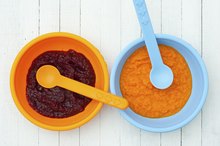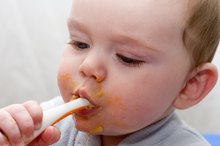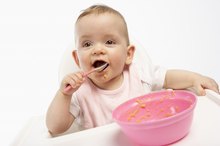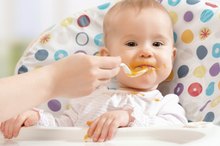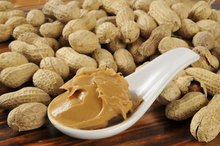How to Mix Cereal With Fruits or Vegetables for Infants
When you start introducing solid foods to your baby's diet, make sure she is ready. Signs of readiness include physical development, such as sitting up and being able to hold up her head, as well as cognitive development, such as showing an interest in food. Once your baby has experienced rice cereal or other grains without issue, it's time to mix it up with some fruits and vegetables. Adding fruits and vegetables to your baby's diet typically occurs between six and eight months of age.
Mix the cereal as you normally would, with formula, breast milk or water.
4-Month-Baby Diet
Learn More
Add 1 teaspoon of the pureed fruit or vegetable. Pears, bananas and peaches work well as first fruits. Avocado and carrots are typical first vegetables. While it needn't be commercial baby food, the consistency needs to be mashed to a runny puree. Remove any strings or seeds to ensure your baby doesn't choke 1. As your baby begins to enjoy the food more, add more fruit or vegetable to the mixture, working up to 1/4 to 1/2 cup eaten amongst two to three solid food feedings.
Record the results of the new mix. If it causes diarrhea or a rash, it may be a sign that your baby is allergic or sensitive to the food. Remove it from your baby's diet and consult with your doctor. It may be something to try later, or not at all if food allergies run in your family.
Can 4-Month-Old Babies Eat Brown Rice?
Learn More
Wait three days before introducing the next new fruit or vegetable. Three days provides a good window to see how your baby reacts to the new food. If you mix too many foods at once, it can be hard to differentiate and identify which food triggered a reaction.
Tips
Be patient with new foods. Babies often need to try a new fruit or vegetable ten or more times before deciding if they like it.
Related Articles
References
- Baby Center: Age by Age Guide to Feeding
- Kids Health: Feeding your 4 to 7 Month Old
- Koplin JJ, Allen KJ, Gurrin LC, et al. The impact of family history of allergy on risk of food allergy: a population-based study of infants. Int J Environ Res Public Health. 2013;10(11):5364–5377. Published 2013 Oct 25. doi:10.3390/ijerph10115364
- American Academy of Pediatrics. Infant Food and Feeding. AAP.org. Published 2020.
- American Academy of Pediatrics. Committee on Nutrition. Hypoallergenic infant formulas. Pediatrics. 2000;106(2 Pt 1):346-9. doi:10.1542/peds.106.2.346
- Ferraro V, Zanconato S, Carraro S. Timing of Food Introduction and the Risk of Food Allergy. Nutrients. 2019;11(5):1131. Published 2019 May 21. doi:10.3390/nu11051131
- Cabana MD. The Role of Hydrolyzed Formula in Allergy Prevention. Ann Nutr Metab. 2017;70 Suppl 2:38-45. doi:10.1159/000460269
- National Collaborating Centre for Women's and Children's Health (UK). Identification and management of trigger factors. Atopic Eczema in Children: Management of Atopic Eczema in Children from Birth up to the Age of 12 Years. Published December 2007.
- Abeshu MA, Lelisa A, Geleta B. Complementary Feeding: Review of Recommendations, Feeding Practices, and Adequacy of Homemade Complementary Food Preparations in Developing Countries - Lessons from Ethiopia. Front Nutr. 2016;3:41. Published 2016 Oct 17. doi:10.3389/fnut.2016.00041
- Hagan JF, Shaw JS, Duncan PM. Bright Futures: Guidelines for Health Supervision of Infants, Children, and Adolescents. Elk Grove Village, IL: Bright Futures/American Academy of Pediatrics; 2017.
- NIAID-Sponsored Expert Panel, Boyce JA, Assa'ad A, et al. Guidelines for the diagnosis and management of food allergy in the United States: report of the NIAID-sponsored expert panel. J Allergy Clin Immunol. 2010;126(6 Suppl):S1–S58. doi:10.1016/j.jaci.2010.10.007
- Abrams EM, Becker AB. Food introduction and allergy prevention in infants. CMAJ. 2015;187(17):1297–1301. doi:10.1503/cmaj.150364
- Koo YC, Chang JS, Chen YC. Food claims and nutrition facts of commercial infant foods. PLoS One. 2018;13(2):e0191982. Published 2018 Feb 28. doi:10.1371/journal.pone.0191982
- Van den boom S, Kimber AC, Morgan JB. Nutritional composition of home-prepared baby meals in Madrid. Comparison with commercial products in Spain and home-made meals in England. Acta Paediatr. 1997;86(1):57-62. doi:10.1111/j.1651-2227.1997.tb08833.x
- Caffarelli C, Di Mauro D, Mastrorilli C, Bottau P, Cipriani F, Ricci G. Solid Food Introduction and the Development of Food Allergies. Nutrients. 2018;10(11):1790. Published 2018 Nov 17. doi:10.3390/nu10111790
- Kusari A, Han A, Eichenfield L. Recent advances in understanding and preventing peanut and tree nut hypersensitivity. F1000Res. 2018;7:F1000 Faculty Rev-1716. Published 2018 Oct 30. doi:10.12688/f1000research.14450.1
- Daniels L, Heath AL, Williams SM, et al. Baby-Led Introduction to SolidS (BLISS) study: a randomised controlled trial of a baby-led approach to complementary feeding. BMC Pediatr. 2015;15:179. Published 2015 Nov 12. doi:10.1186/s12887-015-0491-8
- Leung AK, Sauve RS. Whole cow's milk in infancy. Paediatr Child Health. 2003;8(7):419–421. doi:10.1093/pch/8.7.419
- Jeffery LA, Karim S. Botulism. [Updated 2019 Nov 30]. In: StatPearls [Internet]. Treasure Island (FL): StatPearls Publishing; 2019 Jan-.
- Nichols BG, Visotcky A, Aberger M, et al. Pediatric exposure to choking hazards is associated with parental knowledge of choking hazards. International Journal of Pediatric Otorhinolaryngology. 2012;76(2):169-173. doi:10.1016/j.ijporl.2011.10.018.
- Awadalla N, Pham T, Milanaik R. Chew on This: Not All First Finger Foods Are Created Equal. Clin Pediatr (Phila). 2018;57(8):889-894. doi: 10.1177/0009922817733701
- Chan ES, Abrams EM, Hildebrand KJ, Watson W. Early introduction of foods to prevent food allergy. Allergy Asthma Clin Immunol. 2018;14(Suppl 2):57. Published 2018 Sep 12. doi:10.1186/s13223-018-0286-1
- Nwaru BI, Erkkola M, Ahonen S, et al. Age at the Introduction of Solid Foods During the First Year and Allergic Sensitization at Age 5 Years. Pediatrics. 2009;125(1):50-59. doi:10.1542/peds.2009-0813.
Writer Bio
Carolyn Williams began writing and editing professionally over 20 years ago. Her work appears on various websites. An avid traveler, swimmer and golf enthusiast, Williams has a Bachelor of Arts in English from Mills College and a Master of Business Administration from St. Mary's College of California.


